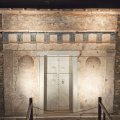Splendid museum and archaeological site in a BC tumulus: tomb of Philip II, rich gold objects, etc.
This museum (Μουσείο Βασιλικών Τάφων Αιγών/Mousio Vasilikon Tafon Aigon) is one of the finest in Greece. It's also an archaeological site, as it's located in the Megali Toumba, a tumulus 100 m in diameter and 12 m high that houses a temple and four monumental tombs from the 4th century BC, in particular, that of Philip II of Macedonia, father of Alexander the Great and conqueror of most of Greece in 330 B.C. Listed as a UNESCO World Heritage Site since 1996, the site was excavated between 1949 and 1977 by archaeologist Manolis Andronikos (1910-1992) and converted into a museum in 1993. After the esplanade, you enter the tumulus via a corridor, then into the large hall, which is almost entirely in darkness: only the display cases, tombs and explanatory panels are illuminated. It takes some time for the eyes to adjust to the darkness. But the museography does a great job of highlighting the remarkable artefacts discovered on site, especially those made of gold, which sparkle in the half-light.
Larnax of Philip II. The two centerpieces are the mortuary crown and larnax of Philip II, who was assassinated in 336 BC. Both are in solid gold. Weighing 717 g, the crown is delicately decorated to imitate the leaves and acorns of an oak tree. The larnax, a small coffin typical of ancient Greek culture designed to house the remains of a deceased person, is a chest weighing 10.5 kg and measuring 40.9 cm long, 34.1 cm wide and 17 cm high. Its upper part is adorned with the "Vergina sun", a stylized sun consisting of a circle surrounded by sixteen rays, which was the symbol of the Macedonian Argeades dynasty (695-310 BC) and has recently become the symbol of Greek Macedonia and, in a more approximate form, of the neighboring country of North Macedonia. The other showcases also contain treasures: gold-edged armor and ivory frieze from Philip II's bed, a huge bronze shield, an ornamental chryselephantine shield (gold and ivory), a gold and silver quiver, bronze leggings, jewelry, spearheads, swords, pottery, silver utensils..
Monumental tombs. Note also the small gold larnax, probably belonging to Cleopatra, seventh and last wife of Philip II, as well as the silver funeral urn and gold crown of Alexander IV, son of Alexander the Great, assassinated in 310 BC at the age of 13-14. All these objects come from the monumental temple-shaped tombs buried in the tumulus. Or, to be more precise, tomb II, that of Philip II, and tomb III, known as the Prince's tomb. The other two tombs (tombs I and IV) and the Heroon (a temple dedicated to Philip II and Alexander the Great) were looted in ancient times. Stairs lead down to the richly decorated facade of tombs II and III. Access to the interior is not possible. However, models recreate the main hall and antechamber of these two tombs. A reproduction also shows the frescoes in Tomb I, known as Persephone's Tomb, depicting the abduction of Persephone (goddess of the Underworld) by Hades (god of the Underworld) on a chariot, with Demeter (goddess of agriculture and Persephone's mother) in mourning. You can end your visit in the store overlooking the main street.
Did you know? This review was written by our professional authors.
Book the Best Activities with Get Your Guide
Members' reviews on AIGAI ROYAL TOMBS MUSEUM
The ratings and reviews below reflect the subjective opinions of members and not the opinion of The Little Witty.

